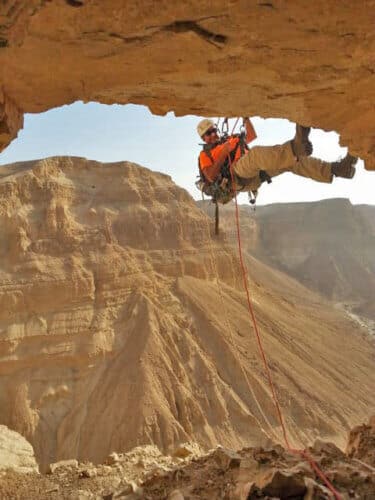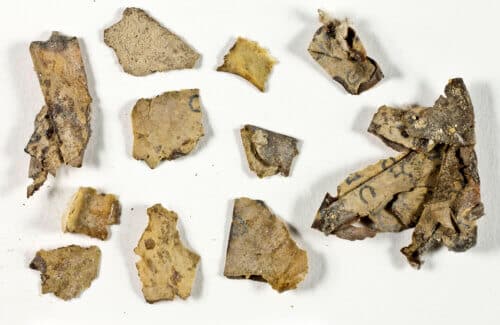This is the first time after about 60 years that fragments of scrolls from the books of the Bible have been discovered in excavations. The sections, which are written in Greek, include remnants from the books of the Ten Prophets, including Zechariah and Nahum * The remains of the scroll and the other rare finds were discovered by archaeologists of the Antiquities Authority in a challenging and dramatic national project designed to eradicate the theft of antiquities in the Judean Desert

"God is the word of God, the word of truth, and the law of God is the truth, and the judgment of peace shall judge you in your gates." BU֙ בִּלבבְק֔ם ושְ֥֥עֹת ש֖זר אֽלֽטִה֑֑בו קִ֧י אַּכּלְלָה אֶַּ֥ר שְ֥אַתִי נָמִהָֽה”
These verses, from Zechariah chapter 1,900, 2017-60, were discovered in a cave of refuge for Jews who fled into the desert almost 6,000 years ago. The verses are written on dozens of pieces of parchment in a particularly challenging and complex national archaeological operation, which the Antiquities Authority has been conducting in the Judean Desert Cliffs since October 10,500, with the aim of eradicating the phenomenon of antiquities theft. The historic discovery comes about XNUMX years since fragments of a biblical scroll were last discovered in an archaeological dig. In addition to the fragments of the scroll, the operation yielded other astonishing findings; A rare hoard of coins bearing Jewish symbols from the Bar-Kochva times, a XNUMX-year-old skeleton, apparently of a girl, who was buried wrapped in cloth and mummified, and a complete XNUMX-year-old basket - as far as is known, the oldest in the world.
The national project for surveying and excavating the caves of the Judean Desert has been ongoing in the caves and canyons of the desert since 2017, at the initiative of the Antiquities Authority, in cooperation with the Judea and Samaria Archeology Staff Officer in the Civil Administration, and funded by the Ministry of Jerusalem and Heritage. Today, its results are revealed for the first time.
The scrolls from the Judean desert include, among other things, the earliest copies of the books of the Bible. As such, they are considered the most important archaeological find of the 20th century. The fragments that were discovered, which contain verses from the books of the prophets Zechariah and Nahum and are written in Greek, were revealed in an archaeological dig in the Judean Desert Reserve, in the "Cave of Terror" in Nahal Heber, which hangs between heaven and earth. The cave is located about 80 m below the top of the cliff, between chasms, and the way to it involves challenging surfing. It will be clarified that the entrance to the cave is prohibited and is dangerous for travelers.
Other findings left behind by the Jewish rebels who fled to the caves at the end of the Bar Kochba rebellion were; A rare hoard of coins from the Bar Kochba revolt bears Jewish symbols such as a harp and a date tree, arrowheads and spears, textiles, sandals and even lice combs.
Since the discovery of the Judean Desert scrolls, over 70 years ago and until today, the caves of the Judean Desert are a target for antiquities thieves; The climate in the caves allows for the exceptional preservation of ancient scrolls and documents - cultural heritage assets of enormous importance. The cave robbers will go after them risking their lives, destroying the caves and the historical evidence.

"The goal of the national operation is to save the rare and important heritage assets in the desert from the clutches of bandits," says Israel Hasson, director of the Antiquities Authority and the initiator of the operation. "The desert team showed courage, dedication and exceptional devotion to the goal, went to the caves that lie between heaven and earth, dug and sifted in them in conditions of thick and suffocating dust, and returned with valuable gifts to human culture", "The unveiling of the new pieces of parchment is a wake-up call for the country", Hasson says. "Resources must be allocated to complete the operation, which is of historical importance. We must make sure that all the information waiting to be discovered in the caves is exhausted before the robbers do so. There are things that have no price."
Director General of the Ministry of Jerusalem and Heritage, Avi Cohen, said: "The fragments of the scrolls, which also include the biblical text, the coins and other findings from the Second Temple period found in the unique project, are direct and faithful witnesses to the Jewish heritage in the region and the inseparable connection between the long-standing Jewish cultural activity and its place in this country. Great excitement to launch these findings and reveal them to the public, findings that shed great light on history. The findings are not only unique and significant for our national heritage, but of importance for the world's cultural heritage. Without the constant activity and professional partnership of the government ministries, the Antiquities Authority and the Civil Administration, these unique properties would not have been accessible to the general public, but would have been the lot of antiquities robbers. The office will continue to be a partner in the project with the aim of completing the mapping of the caves in which there are findings of the same type. The ongoing operation includes a combination of the forces of excellent human factors and advanced technological factors and we are proud and welcome this unique partnership."

According to the Director General of the Ministry of Culture and Sports, Raz Froelich: "This is a historical discovery and on an international scale in this period. Alongside progress and technology, we recall the rich heritage and ancient history of the Jewish people. The importance of the event took on new significance for me, when the excavations were attended by dozens of youths who received a rare opportunity to meet face to face with the Jewish ethos, which has been alive since the days of the Bible. The Ministry of Culture and Sports will continue to invest in revealing our cultural treasures - for the sake of future generations."
According to Hanania Hizami, archeology staff officer at the Civil Administration in Judea and Samaria: "This class is definitely an exciting class, in which we present and reveal to the public an important and significant piece of the history and culture of the Land of Israel. Already at the end of the 40s of the last century, we were exposed for the first time to the heritage and cultural assets left to us by the inhabitants of the Land of Israel with the first discoveries of the Judean desert scrolls. Now in this national project, and following on from previous projects, new findings and testimonies have been discovered and revealed that shed additional light on those periods and cultures in the region. The findings that were discovered indicate a rich, diverse and complex lifestyle, as well as the harsh climatic conditions that prevailed in the region hundreds and thousands of years ago. The KMT Archeology unit in the Civil Administration has invested many efforts and resources over the years, as well as in this operation, with the aim of preserving the antiquities sites throughout Judea and Samaria for future generations, while taking actions and enforcement operations against the antiquities robbers operating in the area."
Since the beginning of the operation in October 2017, teams of the Antiquities Authority, led by Uriah Amichai, Hagai Hamer and Haim Cohen, Methodically, every cave and crevice in the desert cliffs.
According to The directors of the operation, Dr. Ofer Shion, Amir Ganor, Dr. Eitan Klein and Pablo Betzer The Antiquities Authority, so far, has surveyed about 80 continuous kilometers of the cliffs of the Judean Desert. The complex operation included operating drones and reaching hard-to-access caves, using means of surfing and climbing. In addition, archaeological excavations were conducted in selected caves. The meticulous survey, which also included botanical and zoological aspects, is expected to illuminate the study of the Judean Desert caves in a new light. Dozens of teenagers and high school students joined the archaeological excavations, in areas to which relatively easy access was possible. This, as part of the inheritance policy of the Antiquities Authority, which seeks to cultivate in Israel a young generation connected to its heritage.
Excerpts from the Greek scroll of Teri Asar revealed in the sale, were written by two different authors. in conservation and research Edited by Tanya Bitler, Dr. Oren Ibelman, and Beatrice Riastra From the Judean Desert scrolls unit at the Antiquities Authority, 11 lines of writing have been recovered, partially preserving the Greek translation of verses XNUMX-XNUMX in the book of Zechariah, chapter XNUMX. Likewise, in another section, the verses from the book of Nahum XNUMX:XNUMX-XNUMX were identified: The mountains roared from him, and the hills melted; And the earth will be washed away from his face, and everyone who lives in it will dry up; Before his wrath, who will stand and who will rise in Haron Apo, his anger melted like fire and the chains were released from him. A comparison of the text that was preserved in the newly discovered sections, with the known text, reveals quite a few differences, some of them very surprising. These differences testify to the process of the formation of the biblical text until the end of the Bar Kochba rebellion, and help to understand the chain of transmission of the ancient manuscripts, up to the text known today. Another exciting detail is that, although the scroll was written in Greek, which was the dominant language in the Eastern Roman Empire (similar to today's English), the explicit name was written in the ancient Hebrew script, which was used in the days of the First Temple.
In the interior of the horror cave and near its side, another amazing discovery was revealed: A skeleton of a boy or girl from 6,000 years ago, wrapped in cloth, which underwent a mummification process.
Under two flat stones, a dug alcove was revealed and it contained a skeleton, apparently a girl. The girl was placed in the fetal position and she was covered with a cloth that wrapped her head and upper body like a small blanket, with her feet sticking out. It was evident that whoever buried the girl, wrapped her and pushed the edges of the cloth under her. The girl's hands were tucked close to her body. The girl's skeleton and the cloth that wrapped it were remarkably preserved as a result of the climatic conditions in the cave and in fact a process of natural embalming (mummification) took place in which the skin, sinews and even the hair were partially preserved, despite the passage of time.
Another discovery, A unit in the world known so far, was discovered by teenagers from the Nopi Euphrates Preparatory School in one of the caves of the Moravat in the Nahal Darga reserve: A complete giant basket with a lid, Even it is exceptionally preserved thanks to the high temperatures and extreme dryness prevailing in the region. The basket dates to the pre-Neolithic period - ceramic - before approx. 10,500 years.
As far as known, This is the oldest basket in the world found completely intact, and therefore its importance is enormous. The volume of the basket, which seems to have been used for storage, is 90-100 liters. The basket provides new and interesting information about the methods of storing products 1,000 years before the invention of ceramics. It is braided from plant material, in a method that is not common in the braiding industry. It was found empty, and only a future study of the little soil left inside it will be able to help find out what it was used for and what was buried in it.
The skeleton is being studied these days under the leadership of Ronit Lofo from the Antiquities Authority and Dr. Hila Mai from the Tel Aviv University School of Medicine. The earliest complete basket in the world was studied under the leadership of Dr. Naama Soknik and Dr. Yanir Milevski from the Antiquities Authority. The skeleton and the basket were dated using carbon 14 by Prof. Elisabetta Boerto from the Scientific Archeology Unit at the Weizmann Institute of Science.
1.

2 תגובות
With regard to the fragments found from the Teri Asar, it can be assumed that there were Greek Jews who guarded the crucible of their quarry, but were persecuted by the Turks in the Ben Kusaba rebellion, perhaps such as the "Galaim" mentioned in one of the mutineers' accounts. The persecuted found hiding in the caves of the eastern coastline of the Dead Sea. It should be noted that some of Ben Kusava's agoras were written in Greek and were even wrapped in a wrapper depicting Hellenic elements such as Heracles fighting a lion.
It should be noted that the Greek translation of Teri Esher points, so it seems, to a considerable group of Jews, Greeks or close to Greeks, who did not distance themselves from Judaism at all, but were persecuted by Ben Kusva and his supporters, as appears, and at least implicitly from the sources of Sages and Ben Kusva's writings, which may They were identified by him as traitors as "scumbags" in one of his fees. And lest the pursuit of his opponents, at least potentially, such as stuck people. These haunted people found a permanent way of escape by escaping to the cave areas along the eastern line of the Dead Sea and with them biblical scriptures and even seal impressions with a Greek-Hellenistic style and even a pagan image such as the imprint of the legendary Heracles' fight with the lion. It is interesting to note that in some of Ben Kusaba's own agros we find writing in Greek, and in one of them appears "Simon Kusiba", aka Shimon ben Kusaba.